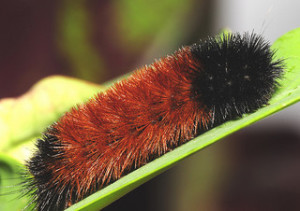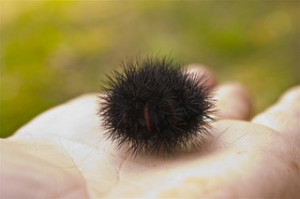Woolly Bear Winter Weather Predictions
By Chris Williams on November 10, 2014.

 They’re called woolly bears or fuzzy bears, or woolly worms in the South. In some places they’re called hedgehog caterpillars because they roll into a tight ball and play dead when disturbed. Woolly bears are actually the larval form of a tiger moth, most often the Isabella tiger moth, but they’re better known in folklore as predictors of winter weather. They’re so popular that there are several woolly bear festivals around the country that feature woolly bear races and of course, weather prognosticating.
They’re called woolly bears or fuzzy bears, or woolly worms in the South. In some places they’re called hedgehog caterpillars because they roll into a tight ball and play dead when disturbed. Woolly bears are actually the larval form of a tiger moth, most often the Isabella tiger moth, but they’re better known in folklore as predictors of winter weather. They’re so popular that there are several woolly bear festivals around the country that feature woolly bear races and of course, weather prognosticating.
Woolly bears are large caterpillars that are very fuzzy or prickly and are banded in black at both ends with a reddish-brown middle. They become noticeable in the fall when they leave their various food plants and wander, looking for a place to spend the winter.
Predict the Weather, Amaze Your Friends!
Folklore says that the wider the black bands on a woolly bear caterpillar, the longer, colder, and snowier the winter will be. Conversely, the wider the reddish-brown band in the caterpillar’s middle (and the smaller the black bands on each end), the milder the winter will be. If you’re an expert at woolly bear predictions, you know that if the head end of the caterpillar is dark, the first part of the winter will be severe. If the tail end is dark, the latter part of the winter will be severe. And you can make your predictions even more detailed. Woolly bears have 13 abdominal segments which correspond to the 13 weeks of winter. The coloration (black or reddish-brown) of each week’s segment will predict the severity of the weather for that week.
Other versions of woolly bear folklore say that the caterpillar’s degree of “fuzziness” tells how severe the winter will be, and if the caterpillar is seen moving south, it indicates a cold winter up north. Woolly bears heading north mean a mild winter.
Now for the Scientific Debunking
Woolly bears have different banding and different amounts of black vs. rust bands mostly because they are different species. In any one fall, the caterpillars do not all look the same because you are seeing larvae from different tiger moth species, each with their own specific larval banding. Beyond that, an individual caterpillar’s coloration also depends on its age and how long it has been feeding on plants. Each caterpillar molts or shed its skin 6 times before it turns into a moth. With each molt, it becomes more reddish and less black. In a good growing season with plenty of food, caterpillars grow bigger and their middle reddish bands become narrower. So, the width of the banding does have something to do with weather, but it’s the weather of the season just past that accounts for the variation, not the winter to come.
But don’t be disappointed, this true fun fact is much more interesting than folklore predictions. The woolly bear’s fuzzy coat serves an important purpose in helping it to freeze successfully. Once the caterpillar finds a good spot for the winter, it produces a natural antifreeze in its body called glycerol that allows it to freeze gradually without harm. Woolly bears can survive temperatures as low as -90° F. and have been known to survive an entire winter frozen inside an ice cube.
Photo credit: graftedno1 / Foter / CC BY-ND
Photo credit: ikarl67 / Foter / CC BY-ND
Sign up for our biweekly email newsletter for more information about bugs and pests!